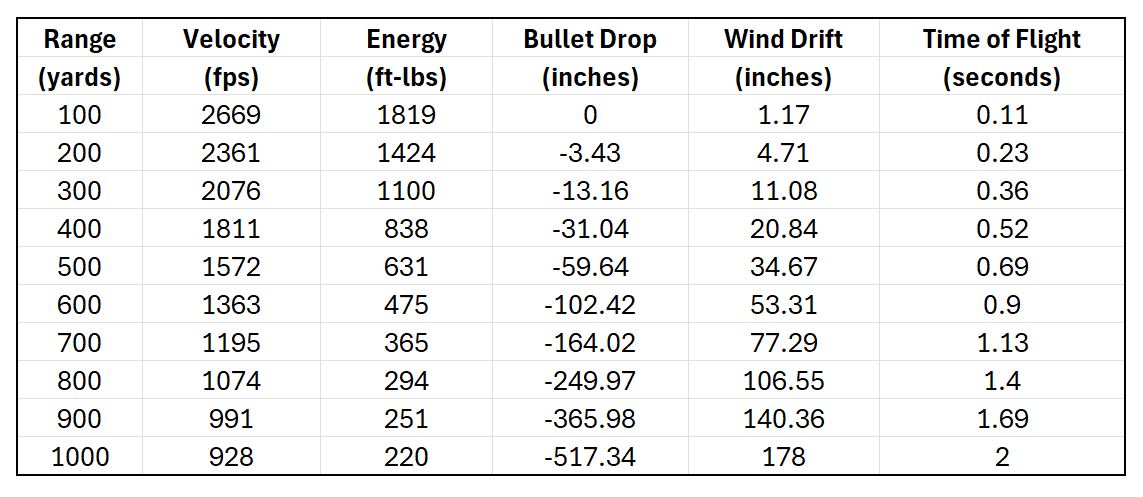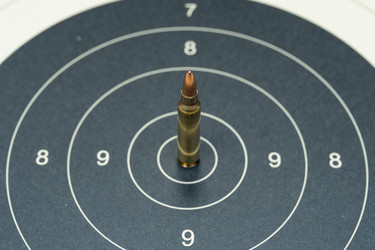What is Ballistic Coeffient? Bullet Accuracy Explained
Posted by 80-Lower.com on Jun 18th 2024
Lots of math, physics, and engineering have gone into maximizing the accuracy of modern firearms, including the rounds we chamber. Ballistic coefficient (BC) is one way of calculating the accuracy of a bullet in flight -- but what, exactly, does it represent? Let's explain.
What is Ballistic Coefficient?

BC measures the ability of a bullet to overcome air resistance in flight.
Air resistance imparts turbulence on the bullet as it travels, affecting its trajectory by pushing the bullet up, down, left, or right. This affects a bullet's accuracy by reducing the consistency between point of aim (POA) and point of impact (POI).
The following factors are included in the calculation of a bullet's ballistic coefficient:
- Bullet mass: How much "bullet" there is. Known by most shooters as grain weight.
- Bullet length: The physical length of the bullet.
- Bullet density: How compact the bullet's mass is.
- Drag coefficient: How effectively the bullet cuts through the air.
- Cross-sectional area: The diameter of the bullet, which varies from tip to tail.
How is Ballistic Coefficient Represented?
The five factors above -- mass, length, density, drag coefficient, and cross-sectional area -- are measured and calculated using the BC equation. What results is, thankfully, a singular number represented on a scale between 0.0 and 0.1.
There are two version of BC calculations -- called G1, and G7 -- but we'll compare the two later. When it comes to either measurement, the simple thing to remember is this:
The higher the number, the greater the ballistic coefficient, and the greater the round's accuracy.
What Increases or Decreases BC?
Bullets with more mass, narrower cross-sectional areas, and higher densities overcome air resistance more effectively. In other words, a sleek, long, heavy rifle round with a narrow tip and tapered bottom will yield a higher ballistic coefficient than a lightweight, wide round with a blunt nose and flat bottom.
Does Ballistic Coefficient Measure Bullet Drop?
Yes. Because air resistance slows the velocity of a bullet, ballistic coefficient can be used to calculate bullet drop. But to accurately calculate bullet drop using BC, the round's muzzle velocity, zero distance, and distance to impact must also be known.
Berger Bullets makes a convenient ballistics calculator. If you know your round's BC, muzzle velocity, grain weight, diameter, and wind conditions downrange, you can produce a relatively accurate range card using this tool.
Velocity Matters Less Than You Think
To illustrate why ballistic coefficient is so important -- and why simply maximizing velocity isn't the best way to guarantee accuracy -- let's compare two rifle rounds of the same caliber. One is slower but enjoys a high BC, and one is far quicker but suffers a lower BC.

For this comparison, we're calculating bullet drop, wind drift, and time of flight of both bullets using a 10 MPH cross-wind traveling perpendicular to the bullets' direction of travel. Both rounds are being fired from the same rifle, so both rounds experience the same barrel length, twist rate, and zero distance.
Which round will suffer less drop and drift? Let's find out.
168-grain .308 Winchester
Our first round is a 168-grain .308 with a relatively high BC (G1) of 0.489. Its muzzle velocity is measured at 2,570 FPS. The chart below shows the round's bullet drop, wind drift, and flight time between 100 and 1,000 yards:

Data credit: Berger Bullets
115-grain .308 Winchester
Our second round weighs 115 grains, with a BC (G1) of 0.289. Its muzzle velocity is far higher, measuring exactly 3,000 FPS. Its bullet drop and wind drift is calculated between 100 and 1,000 yards:

Data credit: Berger Bullets
Surprised by the results?
Most shooters believe a faster bullet always travels along a flatter trajectory. And many believe a faster round suffers less wind drift, because it must have a shorter time of flight -- and, therefore, less time for the wind to push the bullet off its target.
But the data shows this isn't always true.
Those beliefs depend on the distance a round travels. Although in this example the lighter, faster round reaches certain distances quicker, with less bullet drop, drift, and travel time, the effects of air resistance eventually give the advantage to the slower, heavier round because of its higher BC.
By the time both rounds reach 1,000 yards, the 168-grain drops 433" and drifts 107". The 115-grain round drops 517" and drifts 178".
Even more surprising are both bullets' velocities and times of flight: The 168-grain round retains more speed and reaches its 1,000-yard point of impact in 1.77 seconds. The 115-grain round winds up decelerating quicker and reaches that same distance in 2 seconds.
In other words, our heavy, "slow" bullet suffers 16% less drop and 40% less drift, and it reaches the target quicker, representing a significant improvement in long-range accuracy! That's all thanks to the heavier round's higher ballistic coefficient.
G1 vs G7 Ballistic Coefficients

You'll often see two BCs calculated for a given round. One is called the G1 GC, and the other, the G7 BC. Both measurements calculate the same thing -- the round's ability to overcome air resistance -- but these different standards are made to measure different bullet shapes.
There are seven BC formulas for measuring different bullets:
- G1: Flat-base bullets with cylindrical bodies and ogive blunt nose. Used for most pistol rounds.
- G2: Aberdeen J bullets (6-degree boat tail, conical nose).
- G5: 7.5-degree boat tail with 6.19-degree tangent ogive.
- G6: Flat-base bullet with 6-degree secant ogive.
- G7: 7.5-degree boat tail, 10-degree tangent ogive. Used for most rifle rounds.
- G8: Flat-base bullet with 10-degree secant ogive.
- GL: Blunt, lead-nosed bullet.
To keep things simple, almost all bullets' BCs are measured using the G1 and G7 standards
Which Round Should You Chamber?
Now that you understand the importance of ballistic coefficients, you might be hunting for the best rifle round to chamber. Read some of our comparison guides below to see which cartridge is best!
- 6.5 Creedmoor vs. 308 Winchester
- 6.5 Grendel vs. 6.5 Creedmoor
- 5.56 NATO vs. .223 Remington vs. 223 Wylde
DISCLAIMER: If you are new to the world of DIY gun building, you likely have a lot of questions and rightfully so. It’s an area that has a lot of questions that, without the correct answers, could have some serious implications. At GunBuilders.com, we are by no means providing this content on our website to serve as legal advice or legal counsel. We encourage each and every builder to perform their own research around their respective State laws as well as educating themselves on the Federal laws. When performing your own research, please be sure that you are getting your information from a reliable source.

